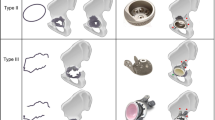Abstract
We describe the clinical and radiological long-term outcomes of 77 primary total hip replacements in 69 patients using the fully hydroxyapatite-coated JRI (Furlong) total hip replacement. The total cases followed up were 77 hips, performed at a mean duration of 11 years and 2 months. Twelve hips could not be followed up for various reasons, which are discussed in the results section. The mean Harris hip score was 89. Seventeen acetabular cups were revised for aseptic loosening. Only one femoral stem was revised, for fracture. By Engh’s criteria there were a further two unstable cups with no symptoms, and all femoral stems were stable. Kaplan–Meier survivorship analysis revealed a survival of 98.8% for the femoral stem, 78.7% for the acetabular cup, and a combined survival of 77.8% for both components. Our findings suggest that the JRI (Furlong) hip gives a durable femoral stem implant fixation, whereas the prosthesis–bone interface achieved with the acetabular component is questionable.
Résumé
Le but de cette étude est d’évaluer les résultats à long terme d’une prothèse de type FURLONG revêtue d’hydroxy-apatite. Pour cela, les auteurs ont étudié le devenir clinique et radiologique de 77 prothèses totales de hanche implantées chez 69 patients en utilisant la prothèse de type Furlong recouverte d’hydroxy-apatite. Le temps d’implantation moyen a été de 11 ans et deux mois. Douze hanches n’ont pu être revues. Le score moyen de Harris a été de 89. 17 cupules acétabulaires ont été révisées pour décellement aseptique, une seule queue a été révisée pour fracture. Selon les critères de Engh, nous avons mis en évidence deux cupules instables, sans symptomatologie clinique. La courbe de survie selon la méthode de Kaplan Meier a montré une survie de 98,8% pour la pièce fémorale, 78,7% pour la cupule acétabulaire et 77,8% pour les deux composants. Notre étude nous permet de penser que la prothèse JRI de Furlong donne des résultats durables notamment en ce qui concerne les pièces fémorales. On peut par contre se poser quelques questions sur l’implant acétabulaire.









Similar content being viewed by others
References
Bloebaum RD, Bachus KN, Rubman MH, Dorr LD (1993) Post-mortem comparative analysis of titanium and hydroxyapatite porous coated femoral implants retrieved from the same patient. J Arthroplasty 8:203–211
Capello WN, D’Antonio JA, Manley MT, Feiberg JR (1998) Hydroxy-apatite in total hip arthroplasty: clinical results and critical issues. Clin Orthop 355:200–211
David A, Eitenmuller J, Muher G et al (1995) Mechanical and histological evaluation of hydroxyapatite-coated, titanium-coated and grit-blasted surfaces under weight-bearing surfaces. Arch Orthop Trauma Surg 114:112–118
Donnelly WJ, Kobayashi A, Freeman MA et al (1997) Radiological and survival comparison of four methods of fixation of proximal femoral stem. J Bone Joint Surg [Br] 79:351–360
Engh CA, Bobyn JD, Glassman AH (1987) Porous-coated hip replacement; the factors governing bone ingrowth, stress shielding and clinical results. J Bone Joint Surg [Br] 79:45–55
Jaffe WL, Scott DF (1996) Current concept review: total hip arthroplasty with hydroxyapatite–coated prosthesis. J Bone Joint Surg 78:1918–1934
Furlong RJ, Osborn JF (1991) Fixation of hip prostheses by hydroxyapatite ceramic coating. J Bone Joint Surg 73:741–745
Havelin LI, Espehaug B, Engesaeter LB (2002) The performance of two hydroxyapatite-coated acetabular cups compared with Charnley cup. J Bone Joint Surg [Br] 84:839–844
Hofmann AA, Bachus KN, Bloebaum (1993) Comparative study of human cancellous bone remodelling to titanium and hydroxyapatite coated implants. J Arthroplasty 8:157–161
Kuo-An Lai, Wun-Jer Shen, Chyun-Hsiang Chen, Chyun-Yu Yang et al (2002) Failure of hydroxyapatite-coated acetabular cups. Ten-year follow-up of 85 Landos Atoll. J Bone Joint Surg [Br] 84:641–646
McNally SA, Shepperd JAN, Mann CV, Walczak JP (2000) The results at nine to twelve years of the use of a hydroxyapatite-coated femoral stem. J Bone Joint Surg [Br] 82:378–382
Rahbek O, Overgaard S, Soballe S, Bunger C (1996) Hydroxyapatite coating might prevent peri-implant particle migration: a pilot study in dogs. Acta Ortho Scand 67 (Suppl 267):58–59
Rokkum M, Brandt M, Bye K et al (1999) Polyethylene wear, osteolysis and acetabular loosening with an HA-coated prosthesis; a follow up of 94 consecutive arthroplasties. J Bone Joint Surg [Br] 81:582–589
Sharma DK, Brooks S, Creasy S, Lewis B (2004) Fracture of fully hydroxyapatite-coated titanium femoral stem of a total hip replacement—a report of 3 cases. Acta Ortho Scand 75(6):768–771
Shen WJ, Chung KC, Wang GJ, McLaughlin RE (1992) Mechanical failure of hydroxyapatite and polysulfone-coated titanium rods in a weight bearing canine model. J Arthroplasty 7:43–49
Soballe K, Hansen ES, Brockstedt-Rasmussen H et al (1991) Bone graft incorporation around titanium alloy and hydroxyapatite-coated implants in dogs. Clin Orthop 272:255–258
Author information
Authors and Affiliations
Corresponding author
Rights and permissions
About this article
Cite this article
Sharma, D.K., Brooks, S. Long-term follow-up (11 years plus) results of JRI (Furlong) total hip arthroplasty in young patients: cause for concern regarding acetabular cup?. International Orthopaedics (SICOT) 30, 375–380 (2006). https://doi.org/10.1007/s00264-006-0083-1
Received:
Revised:
Accepted:
Published:
Issue Date:
DOI: https://doi.org/10.1007/s00264-006-0083-1




